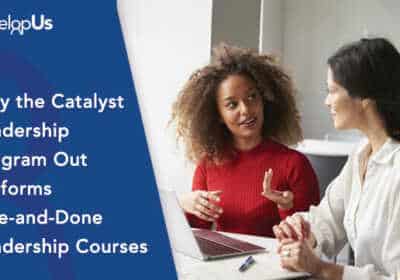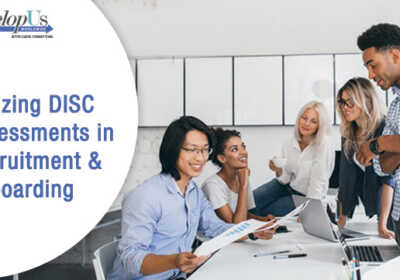Women in Learning and Development: How it Shaped Me.

How it started
“I don’t think you get it.” The words I needed to hear to set me on my path of self-growth and discovery, which ultimately led to a career change. I had just received my rejection email from the HR team of a large healthcare organization for a facilitator position. I had created my own materials and facilitated a 20 minute ‘Servant Leadership’ training as part of the interview process. Having been a department corporate trainer for new hires and processes for 5 years, and with my 3-inch binder of “portfolio” work in hand, I thought I had it in the bag. I responded to the email asking for feedback. I wanted to know what I did wrong and how I could improve my chances of being on this or another Learning and Development team in the future. One of the senior facilitators on the team made time to meet me for lunch. I had already learned so much just from the interview process and I was eager to hear what she had to say. She told me that she wanted to meet with me because she could tell that I had worked hard to prepare but she didn’t think I understood what it really meant to be a part of that team. She explained the process the entire team follows to prepare for the training they offer to the entire organization. It went a little something like this (added on for my learning since then):
Evaluators
Evaluation in learning and development is a process that starts from project initiation and continues all the way through to completion. The evaluator might start this process by conducting phone interviews with previous learners of the same or similar programs. A discovery and analysis call with subject matter experts may follow. A job-site observation may even be in order depending on the situation. Data is collected on both learner context and subject matter. This team had a dedicated evaluator who contacted past or potential learners before, during, and after program implementation to collect useful data. They also created surveys and intake forms for training requests.
Instructional Designers
These are the individuals who design the bones and flesh of the program. They take the data collected by the evaluators (sometimes one and the same) and turn it into a cohesive outline, script, or storyboard to be reviewed by subject matter experts and packaged in a learnable format. This team required their instructional designers to facilitate programs 2 times a year to stay familiar with the content.
Developers
These roles are sometimes filled by Instructional Designers. These are the people who make the outline, storyboard, or script content look pretty. They’ll create the PowerPoints, e-Learnings, job-aids, and other participant handouts. Marketing may be involved for creating specific graphics and keeping materials on-brand.
Quality Reviewers
One of the least visible but most important roles of a team like this. Whether this is a full-time role or a combination of one or many other roles on the team, the target of the reviewer is the same – find all errors and provide solutions for them if possible. This person is looking at every single word or symbol on the page to make sure spacing, tone, and branding is consistent; they are clicking every button to make sure programs work the way they should; and they are the last line of defense.
Facilitators
This role is the most visible position on the team. But as I’d learned up to this point, they are not a team of 1. This person usually has subject matter expertise of their own, having experience in the topic (s) they are responsible for facilitating, thus also being able to provide input in the evaluation process. The senior facilitator I was speaking with had previous years of experience in leadership. This experience gives the facilitator a lens into the lives of their learners, allows for amazing storytelling, and lends credibility to open discussions and problem-solving opportunities in the middle of any given session.
Administrators
The learning administrator handles all the logistics of training. They upload content to Learning Managements systems, create course offerings, open and track registrations & rosters, and handle any resulting communication between managers, learners, and stakeholders. They serve as learning assistants and make sure all supplies are ready to go for any in-person deliveries and they help with learning documentation storage, among many other little things. Many learning professionals handle these tasks themselves. This team had one dedicated administrator.
Learning & Development and STEM
As I thought about what I learned in this conversation, I started to consider my own role. I now had a clear picture of what it took to run a functioning L&D team supporting 80,000+ employees. I had been doing some version of all these things on my own up until that point for a small but constantly expanding department I was asked to lead the training initiative for a few years before this. I prepared training material, facilitated it, evaluated new hires, quality checked their work and my own, tracked rosters and registrations, and designed fully functioning 80-day onboarding programs for at least 4 different positions on the team. However, I had never heard the term “Instructional Designer” before this, and I had yet to tap into the amazing technological potential that learning tools can provide.
I became curious, and that curiosity led me to graduate school. In my education – learning, design, and technology program – I learned many things, but there were two things that stuck with me the most. First, instructional designers not only design learning for people, but they help determine if learning is even needed as the solution. Maybe processes need to be improved, or resources need to be more accessible. Maybe it’s a cultural issue instead. There are scientific models that can be used to determine this, including the PI/HPT Model (Performance Improvement or Human Performance Technology), which includes a gap analysis, interventions and techniques, and a business case for how to move forward. The second thing that piqued my interest was, “If learning is the solution, then what type of learning would be best?” Another scientific model can be used to make this determination – the ADDIE model (Analysis, Design, Development, Implementation, and Evaluation). During the analysis phase, many things are learned about the nature of the audience, their experience, their context for learning, and the type of content being offered. Instructor-led training isn’t always the answer. Maybe micro-learning, eLearning, or on-the-job training are the best options. When we step into the world of eLearning or technology-based learning (or what I call “the fun part”), there are a few tools that can be used to create a quality interactive product for clients. These tools include Articulate Storyline, Adobe Captivate (best for software simulations), Vyond (best for cartoon animation), Camtasia (best for video editing), and more. There are even more technology sites that can be used for hosting content and resources (MS SharePoint, HTML based websites, Google suite, and LMS). While I have only named a few, there are countless software tools and applications used by learning professionals to create graphics, presentations, and more.
The level of problem solving and genuine inquisitiveness that this field provides struck my interest and has kept me loyal ever since. I no longer had my sights on the visible and sometimes unforgiving position of being a facilitator. I wanted to analyze and create from the background, while still having my ears open to what goes on in the classroom. I’m grateful to have stumbled upon this failure – not acing an interview – that taught me more than I had known about my chosen field since I’d been a part of it.
Women in L&D
As I reflect on what I’ve done and where I’ve been since this conversation, I’ve noticed that there is a common thread in all my learning and personal development: Women. The senior facilitator who opened my eyes to what was possible. My mentor at the time (A former L&D facilitator) who wrote a glowing recommendation letter for me on more than one occasion. The directors of my master’s program. Every group project I participated in during my time at UNCC. The Learning and Development Manager who took a chance on me and gave me my first job as an Instructional Designer in a private healthcare practice. The team I joined within this practice with whom I worked alongside to introduce eLearning and web community resources to our organization. A freelancer bootcamp course I participated in during the pandemic when I was considering going solo – led by three women business owners who encouraged other women to open their own businesses and build key relationships within the industry. And lastly, the owner of the organization I work for now – the most thoughtful and authentic boss/mentor/leader I’ve ever been privileged to serve under. Thinking about all these interactions that helped shape me for better or for worse, it is not lost on me that we are still celebrating Women’s History Month. While I cannot detail the obviously big footprint previous women have left on the industry, I can humbly relate to how most of our natural proclivities allow us to fit right in here.
I consider Learning & Development to be a selfless trade. We’re not in this simply nor solely for the betterment of ourselves. We care about the development of others. We want to share our lifelong love of learning with others. Much like our natural inclinations to be nurturers, caregivers, and empathetic beings, prioritizing the learning and development needs of those we serve can and does fulfill our souls. Instructional Design is but a branch in the larger L&D tree, but its bough is thick, and its twigs reach further than one can imagine. Just think of some of the myriad of questions we ask through the life cycle of any project. During the analysis phase we might ask, “What reaction have you received from your learners in the past regarding training like this?” In the development phase where we’ll wonder, “How can we make navigation easier on the learner with easy-to-follow on-screen instructions as needed?” In the pre-implementation quality evaluation, questions like this may be asked: “Will any part of our technology distract or frustrate a learner as they go through our learning journey?” or “Have we honored the branding and corporate guidelines of the organization we’re serving?”
While any product may go through multiple levels, our final customer, the learner, is constantly top of mind. Their development and user experiences are as important to us as it is to them. I know and have met some excellent men who share our passion for this field. However, as a woman in L&D, I can say with complete assuredness that it is my love for learning and the development of others that keeps me here – like many of my female colleagues.
At developUs, this love shows up even in our logo. The ‘develop’ leans towards the ‘U’ on purpose. The focus on personal accountability in both leaders and the teams they serve helps this development happen naturally. From our course offerings to our training process outsourcing services, our emphasis on developing others is embedded in everything we do. Find out more about how I can serve you, how we can serve you by emailing us at info@developus.com.
Written by guest contributor and developUs Worldwide’s Lead Instructional Designer, Deborah Rivera.




Leave a Reply